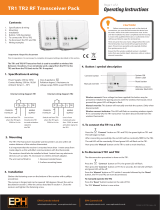
7
3.3 TEST PROCEDURES
A. Power light (D1) does not light.
1. Visually check machine for any damage.
2. Check if fan is running. If not, check following:
a. Check if machine is correctly plugged into mains.
b. Measure voltage level at mains terminal (230V/400-415/440V 3~50/60Hz).
c. Check if circuit breaker Q is closed.
3. If above is OK, check voltage on PCB (PL50) – between test points XP1-XP2 (15V DC±2%):
- if it is OK., check LED D1 on front panel and its connections
- if there is no voltage – check input voltage on connector X1, terminals 9 & 10 (26V DC±10%).
When input voltage is correct, than PCB might be faulty, if PCB is OK, than check fuse F2 (1,6A),
transformer TR2 secondary voltage (terminals 8 & 9, 20 VAC). If above is OK, pull out fuse F2,
disconnect connector X1 and check rectifier bridge PR4 and varistor V1. Depending on test results,
replace faulty apparatus
B. Malfunction of gas valves.
1. Disconnect connector X2 from PCB, check with ohmmeter “AIR TEST” button circuit between
terminals 5 & 6 on female X2, rectify wiring or replace button if necessary and reconnect X2.
2. Check voltage on TR2 secondary terminals 11 & 12 (24 VAC). If not correct, than transformer is
faulty (provided that tests according to 3.2.A.2.a.b.c are OK)
3. Check fuse F1 (1,6 A), replace if open.
4. Disconnect connector X3 and measure voltage between terminals 1 & 2 on female part. It ought to
be 24 VAC, if not check wiring between TR2 and EZ1 check coil continuity and resistance. Rectify
miswiring or replace valve coil if necessary.
5. While X3 disconnected, check with ohmmeter relay contact (K1) between pins 1 & 2 of X3 on PCB.
While “AIR TEST” button is depressed it should be short-circuited, if not PCB is to be replaced.
C. No airflow.
1. Check air supply. Unit requires min. 150l/min @ 4,5-5,2 bars, check supply terminal if necessary.
2. Check air line connections. Tighten if leaking. Check for any obstruction in air line as well.
3. Airflow may be blocked at torch tip. Check torch consumables. Also check for any obstructions in
torch lines.
NOTE: If above is OK, check all parts of air control and distribution circuit as per Fig. 3-7.
D. Start – signal inactive.
1. While depressing torch switch “ON” LED (D3 on PCB) should be lit.
- If not check torch switch and leads. Unplug the torch switch leads at machine terminals, connect
ohmmeter to the leads. After switch is depressed it should read short. If not - switch or leads are
defective.
- If signal “ON” is OK – replace PCB (provided that test of p. 3.2.B is OK)
E. “FAULT” LED (D2) is lit.
1. “FAULT” LED flashes (also when torch switch is released):
a) When machine is cold (i.e. it did not work within last 2÷3 hours) and “TE” LED on PCB (D4, Fig. 3-2)
is lit, that means temperature monitoring circuit is faulty. Disconnect connector X1 from PCB and
check with ohmmeter temperature switch WT1 on main transformer and its wiring (terminals 4 & 8 on
female X1). Rectify wiring or replace WT1 if necessary.
b) When machine is hot, let it cool down. If “TE” LED is still lit, follow above p. a).
2. “FAULT” LED lights continuously, but only when gas valves energised and air flows (also in postflow
mode, i.e. when torch switch is released).





















